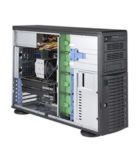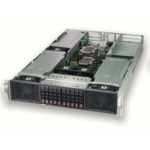Today Supermicro announced fully optimized support on the industry’s broadest portfolio of X11 server and storage systems for the latest 2nd Generation Intel Xeon Scalable processors. This announcement parallels Intel’s launch of these new processors today. “Supermicro has optimized its X11 server and storage systems to fully leverage the performance advantages of the latest 2nd Gen Intel Xeon Scalable processors (formerly codenamed Cascade Lake-R or CLX-R) that extend the unique capabilities including built-in AI acceleration with Intel Deep Learning Boost and support for Intel Optane persistent memory. Supermicro’s advanced thermal management and power supply designs allow these new processors to achieve their full potential in the most comprehensive lineup of server systems on the market.”
WekaIO picks up steam in the HPC Market
Today WekaIO announced it closed its 2019 fiscal year with record velocity in revenues. The company grew revenue by 600% compared to 2018 with growth fueled by increasing adoption of NVMe-native storage systems to enable I/O-intensive applications in Artificial Intelligence (AI), life sciences, and financial analysis. “We are the only tier-1, enterprise-grade storage solution capable of delivering epic performance at any scale on premises and on the public cloud, and we will continue to fuel our momentum by hiring for key positions and identifying strategic partnerships.”
Cortical.io Demonstrates Real-time Semantic Supercomputing for NLU
Today Cortical.io announced the debut of a new class of high-performance enterprise applications based on “Semantic Supercomputing.” Semantic Supercomputing combines Cortical.io AI-based NLU software inspired by neuroscience with hardware acceleration to create new solutions to understand and process streams of natural language content at massive scale in real time. “We are taking the concept of supercomputing to the next level with the introduction of Semantic Supercomputing and the ability to deliver real-time processing of semantic content.”
Supermicro Enhances SuperWorkstations for Desktop HPC
Today Supermicro Computer launched a new server-grade high-end workstation to its broad portfolio of fully configurable SuperWorkstation systems. The SYS-5049A-T joins a robust range of solutions supporting dynamic computational workloads for demanding requirements found in scientific research, deep learning (DL), artificial intelligence (AI), augmented reality (AR), and 3-D modeling with real-time simulation.
Supermicro Launches New High-Performance vSAN Solution
Today Supermicro extended its vSAN system portfolio and introduced a new enterprise-class vSAN solution — Ultra SuperServer — to its broad portfolio of fully configured, ready to deploy server systems. Supermicro solutions, coupled with industry-proven vSAN, provides turn-key solutions for the hyper-converged infrastructure marketplace. “The Supermicro 2U/1U Ultra SuperServers are configurable with support of 20, 10, 4, or 2 hot-swappable NVMe drives and leverage 2nd Gen Intel Xeon Scalable processors and Intel Optane DC SSDs. The BigTwin, a high-density multi-node (2U-4 node) system, is optimized for mission-critical applications supporting up to 6TB memory per node and configured for hyper-converged infrastructure. Both systems are ideal for specific workloads offering operational simplicity, scalability, low total cost of ownership (TCO), and resource-savings for intelligent enterprise deployments.”
Supermicro steps up with EDSFF All-Flash NVMe Optimized Storage
Today Supermicro launched the industry’s first family of server and storage systems that support EDSFF (Enterprise and Datacenter Storage Form Factor) NVMe drives. The latest industry standard NVMe storage is a game changer for the market,” said Jake Roersma, VP of Platform Engineering at Netskope. “A form factor that is optimized for SSD has proven to deliver superior performance while simplifying integration using open standards. Supermicro continues to lead the way by providing the deepest portfolio of NVMe products, best cost, and availability.”
Supermicro steps up with NVIDIA EGX for AI on the Edge
Today Supermicro announced support for the NVIDIA EGX platform, allowing customers to rapidly develop AI applications in their Edge networks. “Enhancing our GPU servers and advanced platforms optimized for AI at the Edge technology with NVIDIA EGX and NGC provides a wide selection of optimized and efficient solutions for the intelligent Edge and for seamless integration from the Edge to the cloud.”
Supermicro teams with WekaIO for Deep Learning Performance Density
The BigTwin Server featuring WekaFS offering is a milestone in our relationship with Supermicro,” said Barbara Murphy, Vice President of Marketing at WekaIO. “The solution is already in use by many customers with deep learning applications and exceeding expectations for performance and value. By offering this preconfigured solution with Supermicro, we’ll be able to simplify the customers’ acquisition experience.”
Supermicro Shipping new Scale-Up In-Memory Computing Platforms with Intel Xeon Scalable processors
Today Supermicro announced that its new 4-socket servers featuring 2nd Gen Intel Xeon Scalable processors and Intel Optane DC persistent memory are now shipping in volume. “Using 2nd Generation Intel Xeon Scalable processors and Intel Optane DC persistent memory, these servers deliver tremendous performance boost for in-memory computing all at a dramatically lower cost compared to the previous generation architectures.”
Supermicro Early Shipments Available: Intel Xeon Servers with Optane DC Persistent Memory
Today Supermicro launched its Early Shipment Program for servers and storage systems that customers can validate using next-generation Intel Xeon Scalable processors which are expected to be officially released later this year. “Supermicro’s entire X11 portfolio is optimized to fully leverage the next-generation Intel Xeon Scalable processors and future innovations including Intel Optane DC persistent memory and Intel Deep Learning Boost technology to enable more efficient AI (artificial intelligence) acceleration.”












